
|
|
|
|
|
|
Classic Bikes
Custom Bikes
Individual
Racing Bikes AJP
AJS
Aprilia
Ariel
Avinton / Wakan
Bajaj
Benelli
Beta
Bimota
BMW
Brough Superior
BRP Cam-Am
BSA
Buell / EBR
Bultaco
Cagiva
Campagna
CCM
CF Moto
Combat Motors
Derbi
Deus
Ducati
Excelsior
GASGAS
Ghezzi Brian
Gilera
GIMA
Harley Davidson
Hero
Highland
Honda
Horex
Husaberg
Husqvarna
Hyosung
Indian
Jawa
Kawasaki
KTM
KYMCO
Laverda
Lazareth
Magni
Maico
Mash
Matchless
Mondial
Moto Guzzi
Moto Morini
MV Agusta
MZ / MuZ
NCR
Norton
NSU
Paton
Peugeot
Piaggio
Revival Cycles
Roland Sands
Royal Enfield
Sachs
Sherco
Sunbeam
Suzuki
SWM
SYM
Triumph
TVS
Ural
Velocette
Vespa
Victory
Vincent
VOR
Voxan
Vyrus
Walt Siegl
Walz
Wrenchmonkees
Wunderlich
XTR / Radical
Yamaha
Zero
Video
Technical
Complete Manufacturer List
|
Ducati 996SPS Foggy Replica
|
|
Make Model |
Ducati 996 SPS Foggy Replica |
|
Year |
1999 |
|
Engine |
Four stroke, 90°“L”twin cylinder, DOHC, desmodromic 4 valve per cylinder. |
|
Capacity |
996 cc / 60.8 cu in |
| Bore x Stroke | 98 x 66 mm |
| Cooling System | Liquid cooled |
| Compression Ratio | 11.5:1 |
| Lubrication | Wet sump |
| Engine Oil | Synthetic, 15W-50 |
|
Induction |
MB1 fuel injection |
|
Spark Plugs |
Champion A55V |
|
Ignition |
Digital CDI |
| Battery | 12V, 16AH |
| Starting | Electric |
|
Max Power |
90.5 kW / 123 hp @ 9500 rpm |
|
Max Torque |
99 Nm / 10.1 kgf-m / 73 ft-lb @ 8000 rpm |
| Clutch | Hydraulically activated dry clutch |
|
Transmission |
6 Speed |
| Primary Drive Ratio | 1.84:1 (32/59) |
| Gear Ratios | 1st 2.466 / 2nd 1.765 / 3rd 1.350 / 4th 1.091 / 5th 0.958 / 6th 0.857:1 |
| Final Drive Ratio | 2.4:1 (15/36) |
| Final Drive | Chain |
| Frame | Tubular trestle frame with upper section made of high-strength steel |
|
Front Suspension |
43 mm Showa shock, adjustable for compression and rebound damping |
| Front Wheel Travel | 127 mm / 4.9 in |
|
Rear Suspension |
Showa mono shock, rising rate, adjustable for compression and rebound damping |
| Rear Wheel Travel | 130 mm / 5.1 in |
|
Front Brakes |
2x 320 mm Discs, 4 piston calipers |
|
Rear Brakes |
Single 220 disc, 2 piston caliper |
| Front Wheel | Alloy, 3.50 X 17 in. |
| Rear Wheel | Alloy, 5.50 X 17 in. |
|
Front Tyre |
120/70 ZR17 |
|
Rear Tyre |
190/50 ZR17 |
|
Rake |
23.5o - 24.5o |
|
Dimensions |
Length 2095 mm / 79.1 in Width 690 mm / 27.2 in Height 1090 mm / 42.9 in |
| Wheelbase | 1410 mm / 55.5 in |
| Seat Height | 790 mm / 31.1 in |
|
Dry Weight |
190 kg / 419 lbs |
|
Fuel Capacity |
17 Litres / 4.5 US gal / 3.7 Imp gal |
|
Consumption Average |
6.1 L/100 km / 16.4 km/l / 38.6 US mpg / 46.3 Imp mpg |
|
Standing ¼ Mile |
10.5 sec |
|
Top Speed |
270 km/h / 168 mph |
|
Road Test |
Although Ducati's water-cooled 8-valve v-twin had been around in its
original 851 and 888 incarnations for six years and had already won four
World Superbike Championships, it was the arrival of the iconic 916 for 1994
that really captured the public's imagination. Styled by Massimo Tamburini,
the 916 and its subsequent evolutions established Ducati as one of the
world's foremost brand names. Universally recognised as icons of automotive
art, Ducati motorcycles have been exhibited in some of the world's foremost
museums, including the Guggenheim in New York and the Museum of Modern Art
in San Francisco.
The original 916 Strada was superseded by the Biposto (two-seat) version and
the higher-specification SP. The latter's engine remained at 916cc but added
twin fuel injectors and bigger valves to the package for increased power and
torque. The SP reverted to a single seat unit (with white number boards)
while gaining superior Öhlins rear suspension. Next came the ultra-exclusive
916SPS (Sport Production Special) derivative of which only 400 examples were
made. Despite the name, the 916SPS enjoyed the advantages of an over-bored
engine displacing 996cc and delivering a mighty 132bhp at the rear wheel.
The cost new was an equally staggering £18,400.
For 1999 the 996 replaced the 916 and one again there was a
higher-specification 'SPS' version topping the range, albeit with a slightly
reduced maximum power output of 123bhp, 10 horsepower more than the base
996. 996SPS chassis upgrades included an Öhlins rear shock and lightweight
five-spoke Marchesini wheels. Showa forks were fitted to the 1999 model but
for 2000 the 996SPS received fully adjustable Öhlins forks incorporating
titanium nitride coated stanchions. The 996SPS's top speed was around 175mph
and this exclusive model cost £18,650 in 1999, making it one of the world's
most expensive production motorcycles.
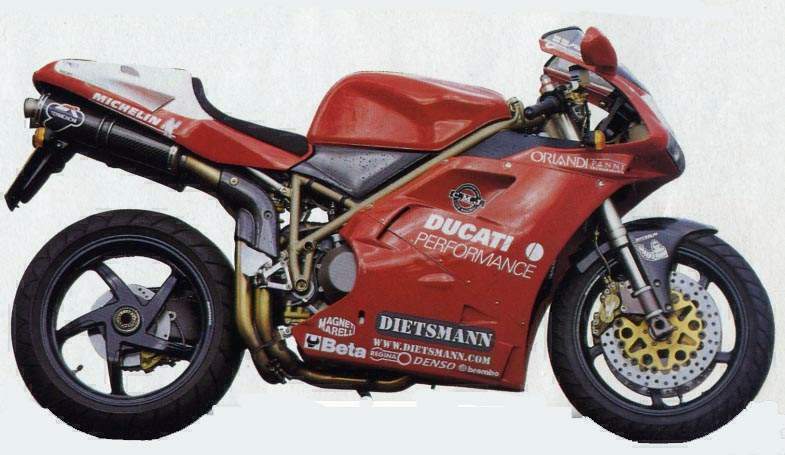
In 1998 Ducati needed to homologate a new frame with a lowered cross brace to allow a larger airbox. Called a Kyalami frame, as it was introduced in the middle of the 1998 season at the Kyalami WSB race in South Africa, it allowed more room for a bigger airbox design that reportedly boosted horsepower considerably. To make the frame race-legal they needed to sell a street version, so the UK-only 916SPS Fogarty Replica was released. 202 were sold in Britain in honour of WSB rider Carl Fogarty; aside from the new frame, you got a set of five spoke Marchesini wheels and a race-replica paint scheme, as well as a few Foggy themed goodies, but otherwise it was standard SPS. Street bikes didn’t even benefit from a larger airbox. Why 202? Because one went to Fogarty and one remained in the factory museum, the remaining 200 were sold to the public. A second Foggy replica was released in 1999, this time 150 examples were made available in Europe, and a third run in 2000 of 147. The Foggy SPS was never officially sold in the US, but we did get the Foggy Monster S4 in 2001.
Back in ‘98 Roland Brown
took an enthralling ride astride the very Ducati which Carl Fogarty had just
ridden to his third WSB title win. Here’s what he had to say at the time about a
"machine from another planet." and Foggy’s hatrick year.
"You smash me bike up and I’ll bloody kill you!"
Carl Fogarty is joking, larking about for the cameras, but behind the shades the
famous Foggy eyes are burning with deadly seriousness too. One of Carl’s bonuses
for winning his third world Superbike title in for Ducati was that he got to
keep the winning bike, and he’s already worked out just where it’s going on
display in his new house near Blackburn — so he doesn’t want it crashed.
Twenty minutes later those words are ringing in my ears along with the delicious bark of a free-breathing 996cc V-twin race motor as I accelerate up the Mugello pit-lane on the factory rocketship that was last seen crossing the Sugo finish-line beneath a jubilant Foggy. This is a magical moment for any motorcyclist: riding one of the fastest and most successful motorcycles ever built on one of the world’s great racetracks.
I’ve been expecting Foggy’s bike to be demanding as well as exciting, but the Ducati is so light and manoeuvrable that I get my knee down on the second bend and it feels great. It sure is intimidating, too, though. I’ve just done a couple of laps on a standard 996 to check out the track, and in isolation the roadbike felt powerful, agile and well-braked. But the difference between the two is mind-blowing.
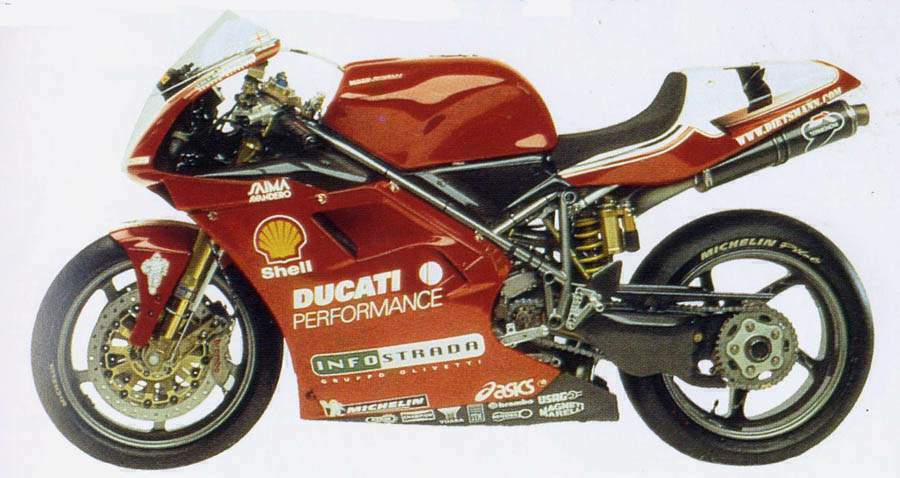
The racebike is a machine from another planet. After the 996, it’s a surgeon’s
scalpel compared to a butter-knife. Trouble is, I’m not making a sandwich any
more, I’m performing open-heart surgery. And one tiny, easily made mistake —
like changing the wrong way with the racer-style, down-for-up gearlever — will
have disastrous consequences.
At times the Ducati is totally thrilling, like the way it rips up the hill
towards the Materassi chicane with a burst of second-gear acceleration, then
slows with almost unbearable force as I brush the front brake lever before
tipping left-right and roaring off again down the hill towards the Casanova
right-hander. It’s just everything you could ever want in a fast motorbike: the
effortless, phenomenally strong acceleration; the impossibly taut feel from
Öhlins’ finest suspension, the stunning braking force, the booming V-twin
soundtrack.
The Duke is exciting too as
it exits the last downhill left-hander onto the start-finish straight, but for a
rather different reason. I’m still hanging off to the left as I get back hard on
the gas and the bike rockets forwards, handlebars snapping from side to side and
the Ducati threatening to veer off the track as its front wheel goes light. I
desperately haul myself back into the seat and have to shut off momentarily.
When it’s back under control I tread down repeatedly to flick up through the
quick-shift aided gearbox, throttle wide open as the 996cc V-twin’s 158 horses
hurl me down the straight at breathtaking speed.
By the time I hit the brakes at the end of the straight I’m doing over 170mph on
this thrillingly fast motorbike (whose top speed is 190mph-plus). But I have to
admit it: on an unfamiliar, technical track like Mugello the works Ducati is so
powerful, responsive and just so different that in my first short session I
rarely feel at home.
Second time round I’ve slightly more idea where I’m going, and the faster I ride
the better the Ducati feels. Its suspension is still set-up firm for smooth Sugo,
but Mugello is bumpier and a couple of the other riders have complained that the
shock is too stiff. But I’m heavier and for me it’s fine. And if I keep the revs
up — Foggy rarely drops below 9000rpm — and hold my weight forward as I
accelerate out of that last left-hander, the bike doesn’t wobble so much.
Even so, as I head back to the pits after my handful of laps I know I’ve barely
scratched the surface of the factory 996’s potential. The increased power and
smoother delivery of this year’s Ducati make it a faster and better-handling
bike than the wayward machine that even Foggy struggled to control in ’97.
Finding its limits, really making use of all its performance, is something that
only world champions can do. But at least I brought it back in one piece, eh
Foggy?
Despite strict Superbike rules Foggy’s bike shares few parts with a stock 996.
The factory race engine no longer contains as much exotic metal as in the past,
because the Ducati can hit the 162kg weight limit without. But it still has hot
desmo cams, huge lightweight valves, titanium rods, 12:1 compression ratio,
special crank and too many other trick bits to mention. That claimed peak output
of 158bhp at 12,000rpm means this bike is 35bhp more powerful than a 916SPS.
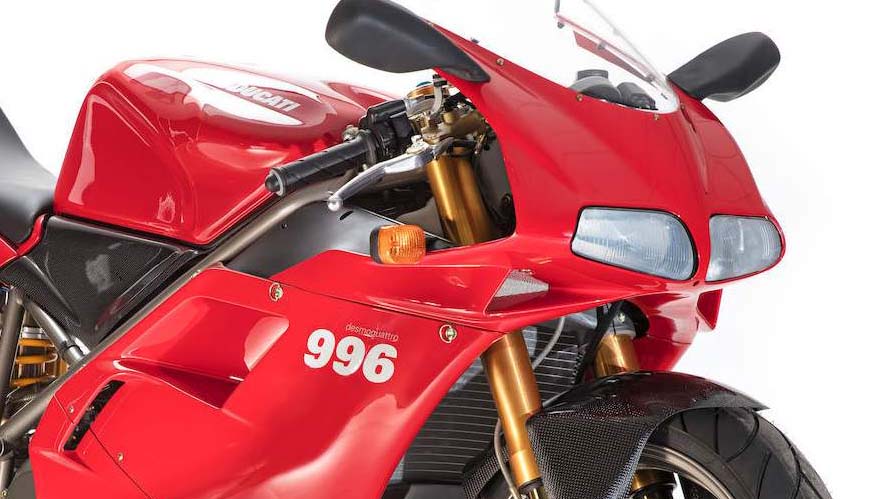
This year’s works motor began the season with a couple of advantages over its predecessor. Its fuel system gained a third injector for each cylinder, because for full-throttle running it’s beneficial to use an injector placed as far as possible from the inlet valves. And it had a new Magnetti Marelli engine-management system that could not only be downloaded as soon as the bike reached the pit, but also reprogrammed from a laptop computer with no need to swap an Eprom chip as before.
The biggest boost came in mid-season, when for the Kyalami round Ducati
introduced a larger airbox and revised intake system. (This required
homologation of a re-routed frame tube, achieved by incorporating the change in
the limited-edition 916SPS Fogarty Replica.) The breathing mod added 7-8bhp,
putting the Ducatis level on speed with Honda. "It’s worth between three-tenths
and half a second a lap — the biggest single improvement we’ve made to the bike
in the last few years," says race team engineering chief Claudio Domenicali.
Chassis changes were less dramatic, although the improved handling of this
year’s bike, largely due to its smoother power delivery, was crucial in Foggy’s
victory. There were no major frame modifications although the Duke benefited
from a more tuneable steering head assembly, plus more sophisticated 46mm
upside-down Öhlins forks. The Swedish firm also produced a new-generation TT4
shock, which Foggy used at some rounds.
Foggy’s Hat-trick Year
"The mistake we made early in the season was changing too much on the bike,"
says Foggy, pointing to the mid-season Laguna Seca round as the turning point in
his third World Superbike Championship winning season. "After that I said,
‘Right, that’s it. We know what the base settings are, now let’s leave the
bloody bike alone.’ For the last four meetings we didn’t change much at all."
Fogarty came good in style towards the end of the season, never finishing
outside the top four in the last eight races as his rivals fell by the wayside.
"Even at Brands [the following round] the bike wasn’t 100 per cent, but I got
two good results there, and after that it was perfect. From then on I was so
strong, compared to the other guys. I finally got the bike and me working
together. It took so long, but we finally did it — in the nick of time, really."
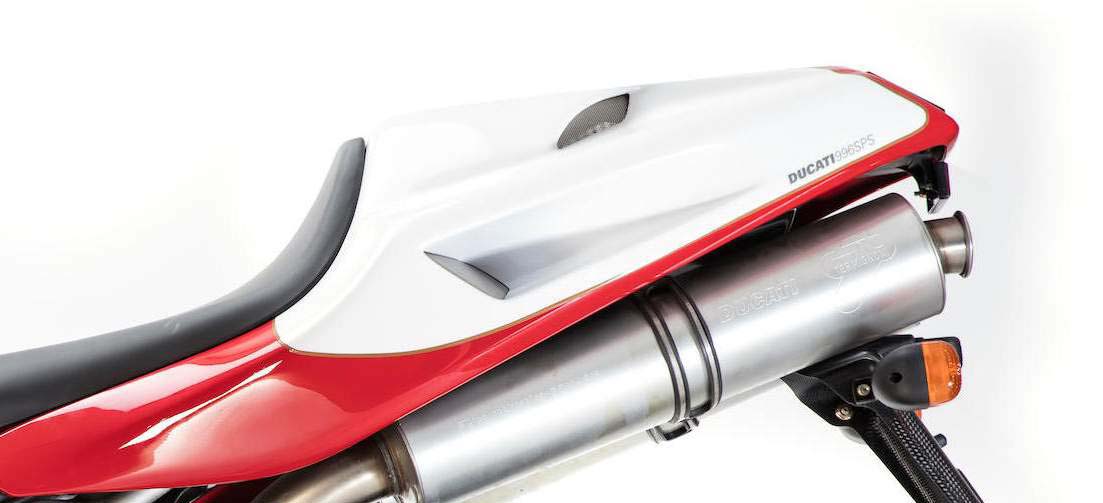
It had been different at the start of the season. "At Monza [Round 2] the Hondas
were so much faster it was ridiculous. But after Kyalami the bikes were very
close, very similar on acceleration and top speed. My bike was good in the
corners, too. It stayed on line, which is what I want in the middle of corners,
and was very smooth when I turned on the gas."
Foggy reckons his riding is just as good as ever, too. "When I’m out there
racing I feel as strong as in ’95, definitely. The motivation goes a little bit
sometimes, especially with the testing and travelling. If I’d finished second or
third I’d be thinking, Oh friggin’ hell, here we go again. But now I’ve won the
championship again I’m really motivated.
"I feel I’m going to be stronger than ever in 1999. This year we had a lot of
problems and just about got them sorted out in time to win the championship.
Next season we’ll be a lot stronger from the start. I just can’t wait to get the
No.1 plate on the front of the bike and go down the pit lane with my head up in
the air, saying: "You’ve got to come and get this off me!"
Source insidebikes.com
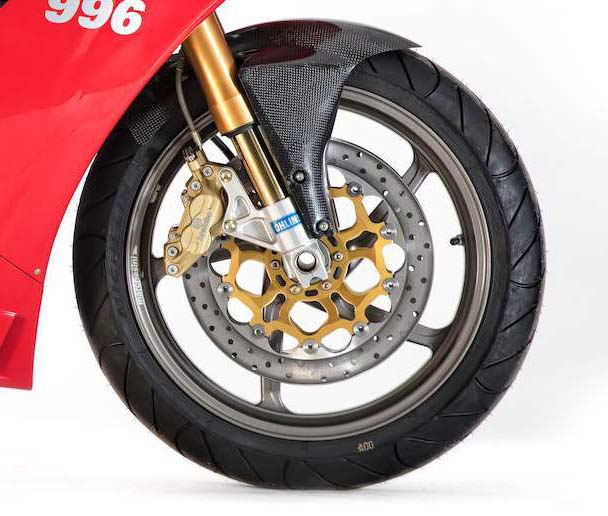
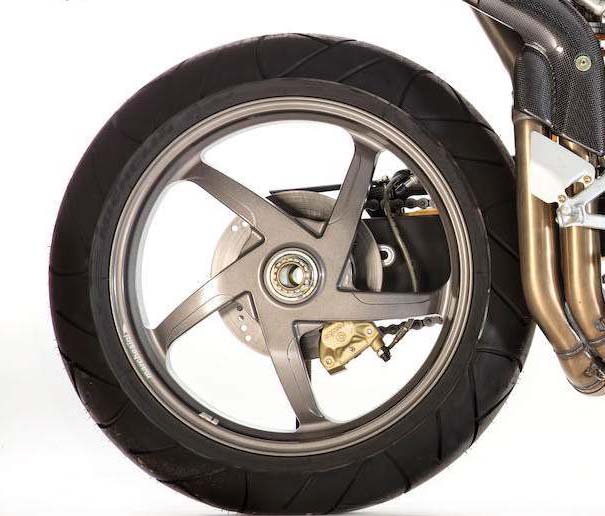
|
Any corrections or more information on these motorcycles will be kindly appreciated. |